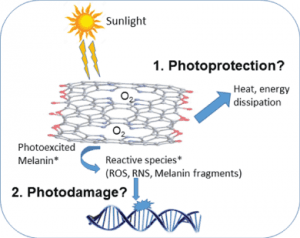Over the past decade, melanin pigments and their subunits have attracted increasing interest as soft biocompatible functional materials with antioxidant properties for engineering high performance, low impact biocompatible optoelectronic devices, such as memory devices, light emitting diodes (LEDs) and field effect transistors (FETs).
Melanin is a natural pigment present in the human body, it is the main skin pigment in mammals, and is considered a broad absorbing sunlight macromolecule. Some of its several functions include; photoprotection, photosensitivity, making it a potential polymer for applications in implanted devices. In 1974, McGines et al. described melanin as an amorphous semiconductor with high energy absorbing properties. In humans, melanin is found at least in hair, skin eyes, internal ear and the substantia nigra in the brain. In hair and skin the major function of melanin is related to its action as a natural sunscreen protector, and therefore it behaves as a photoprotective pigment against harmful solar radiation, especially UV light.

Melanin is essentially an energy absorber with the properties of an amorphous semiconductor. It can absorb many different types of electromagnetic energy but it can also absorb metal ions, free radicals and a number of organic compounds. If the energy input is not very high, the absorbing properties are the basis of its protective action. If the energy input exceeds a threshold, the output will be the generation of chemical species that can damage cellular components, including DNA lesions. Hence, protection can become damage. Melanin is a double-edged sword, it protects with one hand but with the other hand it may place at risk surrounding cells.
Referring to binding of some organic drugs, accumulation of those in a specific melanized tissue could become deleterious. Francisco Solano, University of Murcia, Spain, tried to review the role of epidermal melanin against sunlight taking into account some novel reports concerning melanin structure and possible harmful effects focused on DNA. Read more in Polymer International’s Special Issue: Melanin.

















